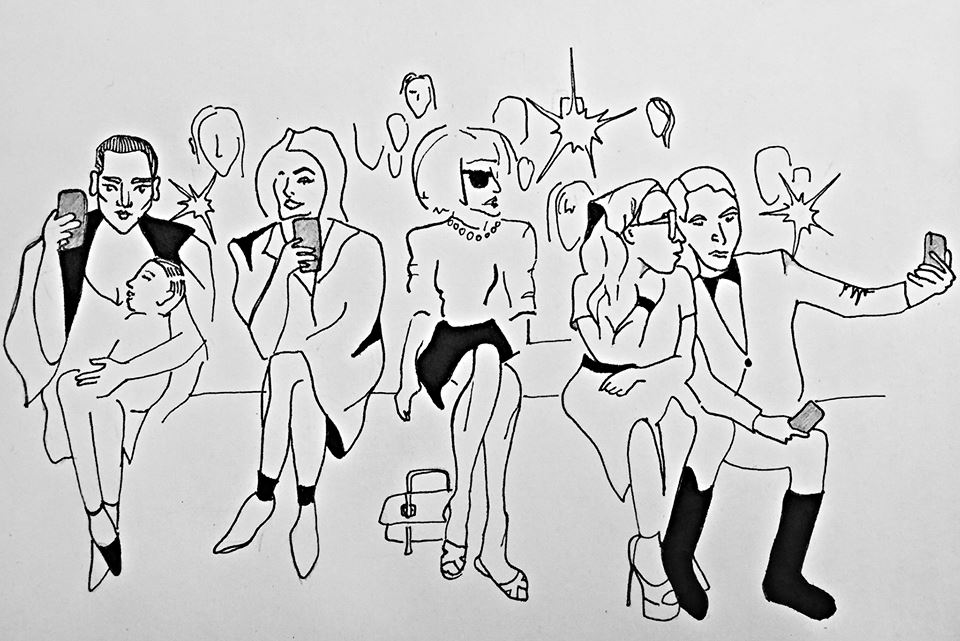Celebrities have always played an integral role in the fashion world, especially when it comes to brand promotion. However, the influence of the rich and famous has never been felt as much as it is in today’s world, where social media allows people to feel as though they have access to the personal lives of celebrities, even if they are just one comment in a sea of thousands. The rise of celebrity involvement has changed the goals of the entire fashion industry. Specifically, in order to capitalize on the public’s obsession with celebrity culture, companies have shifted from their traditional focus on the clothing itself to an emphasis on the particular celebrity who backs the brand. Although the world of high fashion is more popular than it has ever been before, it has come at the price of no longer pursuing fashion for fashion’s sake. In the superficial age of social media, designers know that all they have to do is align their brand with the Instagram or Snapchat star of the moment.
In order to appeal to public interest, many designers have focused their efforts on exciting disinterested audiences with the promise of celebrities modelling their latest collections. Similarly, magazine articles neglect to report on designers’ collections and are more inclined to write about star-studded front rows and after-parties. People eagerly await fashion week because so many high profile celebrities are dressed-up and put on display for the world to see. These people are perhaps just as delighted by the prospect of partaking in the industry’s more humanizing model moments, like watching and re-watching newcomer Bella Hadid trip and fall on the Michael Kors Spring/Summer 2017 runway, a story deemed newsworthy around the world. Fashion shows are no longer lit up by the flashbulbs of the wall of photographers at the end of a runway, but by the glowing cellphone screens of front-rowers invested in getting a clear shot of Kendall Jenner. In a world where it has become harder and harder to focus on the clothing instead of the model, it is always refreshing to see front row veterans such as Anna Wintour and Grace Coddington watching the collections, phoneless and attentive.
Designers who use celebrity models are often better known by the public, as exemplified by the French brand Balmain. Balmain is headed by the 30-year-old creative director Olivier Rousteing, who is an expert at allying his brand with the most relevant celebrities of the day. His #BALMAINARMY, a group which resembles Taylor Swift’s exclusive ‘squad’, boasts such names as Gigi Hadid, Rihanna, Justin Bieber and many more. Not to mention the direct correlation between Balmain and the Kardashians, a brand-defining association to many who would argue that the family have a lot to do with Balmain’s modern-day popularity.
Dolce and Gabanna employed a similarly attention-grabbing tactic at their Spring/Summer 2017 show by inviting young social media stars, including Sarah Snyder, Luka Sabbat and Sofia Richie, to sit front row and attend a highly publicized dinner afterward. Although Dolce and Gabbana is not a particularly youthful brand, the relevance of the event was indisputable, since it became one of the most Instagrammed affairs of the season. Critics have called this somewhat of a cheap tactic, pointing to the fact that there has never been a more visibly bored front row.
And how can we forget that some A-list celebrities – because of their public influence – have managed to bypass the middleman of the designer. Consider Rihanna’s Fenty x Puma and Kanye West’s Yeezy collections. Both lines have been accepted into the world of high fashion with open arms and have had a substantial influence on popular trends.
This is not to say that high fashion as we once knew it is completely obsolete. Select designers have maintained artistic integrity and managed to keep the focus on the clothing itself. However, it is interesting to note that the brands that do so seem to intentionally keep associations with celebrities to a minimum. Such brands include Acne Studios, The Row, Jacquemus, and Celine. These brands should be commended for managing to stay on top without resorting to gimmicky tactics. Indeed, Celine is the antithesis of Balmain in many ways: while Balmain’s high profile creative director boasts 4M followers on Instagram and is considered a celebrity in his own right, Celine’s Phoebe Philo does not have any form of social media and rarely makes appearances. However, staying true to the intended values of the fashion world comes at a price as the lack of social media presence can alienate the public, playing into stereotypes of the fashion industry as cold and exclusive. People are unable to feel the personal connection that they feel to a brand like Balmain and are therefore unable to see a place for themselves in the industry.
While it is true that celebrities have always had a part in the fashion world, the public has never felt so close to the celebrities that they look up to, and the impact of celebrity endorsements has never been as important as it is right now. More and more young hopefuls from generation I-deserve-to-be-famous express their interest in joining the fashion world, even though many lack a genuine enthusiasm for clothing. While this phenomenon has changed the nature of high fashion, it hasn’t brought about its demise. Rather, there now exist two fashion worlds: one that revolves around the celebrity, and one that revolves around the art of clothing design. Most, if not all, fashion designers today can be placed in one world or the other. Ultimately, fashion is a business and designers have an obvious interest in having their brand sold by consumers; unfortunately, this all too often means selling out.



Awesome work Hayley – very interesting!
I’m wondering whether the companies like Balmain that are “selling out” actually possess clothing designs that are of a similar level to the other top brands like Acne Studios. Do these artistic/design-driven companies truly manufacture products of any higher quality? Of course this answer is purely subjective, and can only be determined by public opinion.
My point here is that selling out shouldn’t be viewed upon as a negative thing, as it doesn’t necessarily have any correlation to the quality of a brand’s designs, rather only their marketing strategy. If you disagree with this point, I would like to hear why.